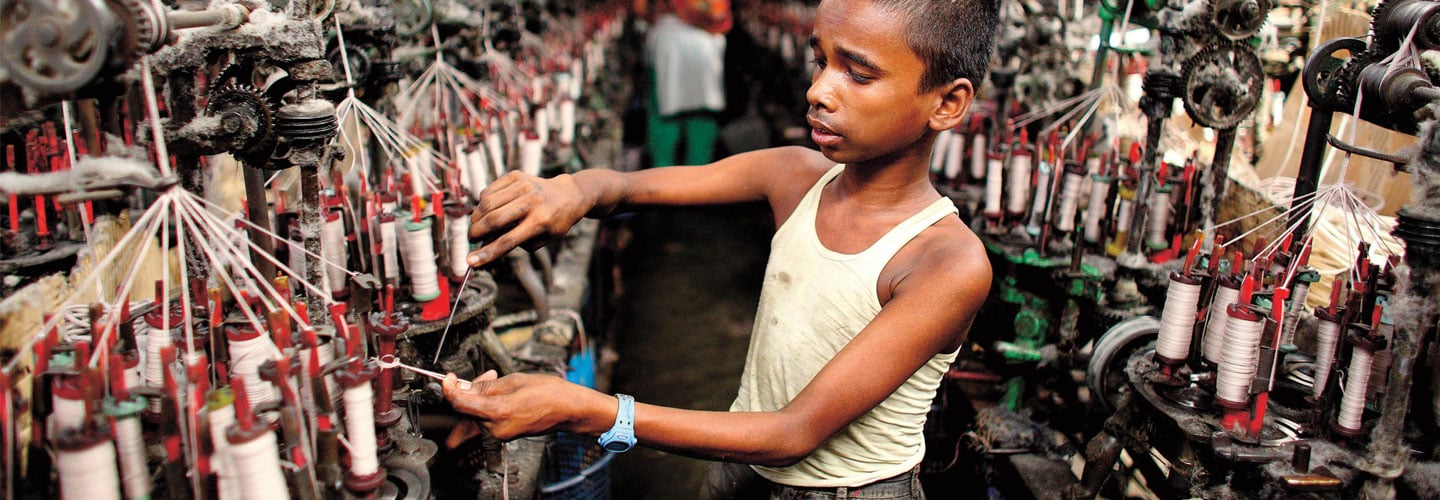
A 13-year-old works in a textile factory in Bangladesh.
The High Cost of Fast Fashion
The latest trends have never been more affordable—but all those cheap clothes come at a price for impoverished workers around the world
Young women hunch over sewing machines in a windowless workroom in the Asian nation of Bangladesh. Elbow to elbow in the stifling heat, they assemble jackets. Together, the women must sew hundreds of jackets an hour, more than 1,000 a day. They are paid less than $3 a day for their work.
Just a week or two later, these same jackets will be fall’s hottest back-to-school item, selling to teens for $14.99 each across the United States.
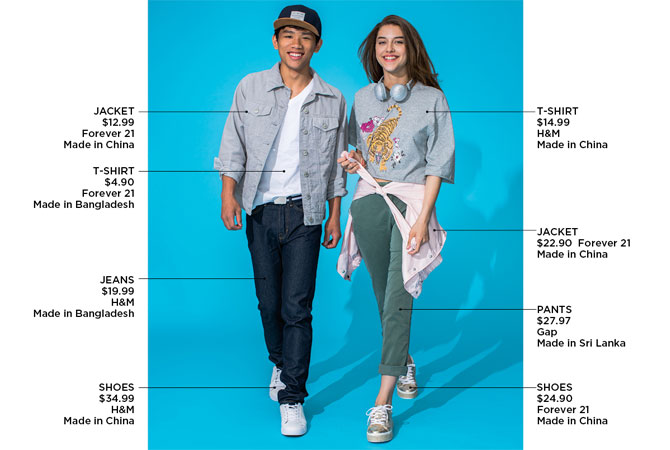
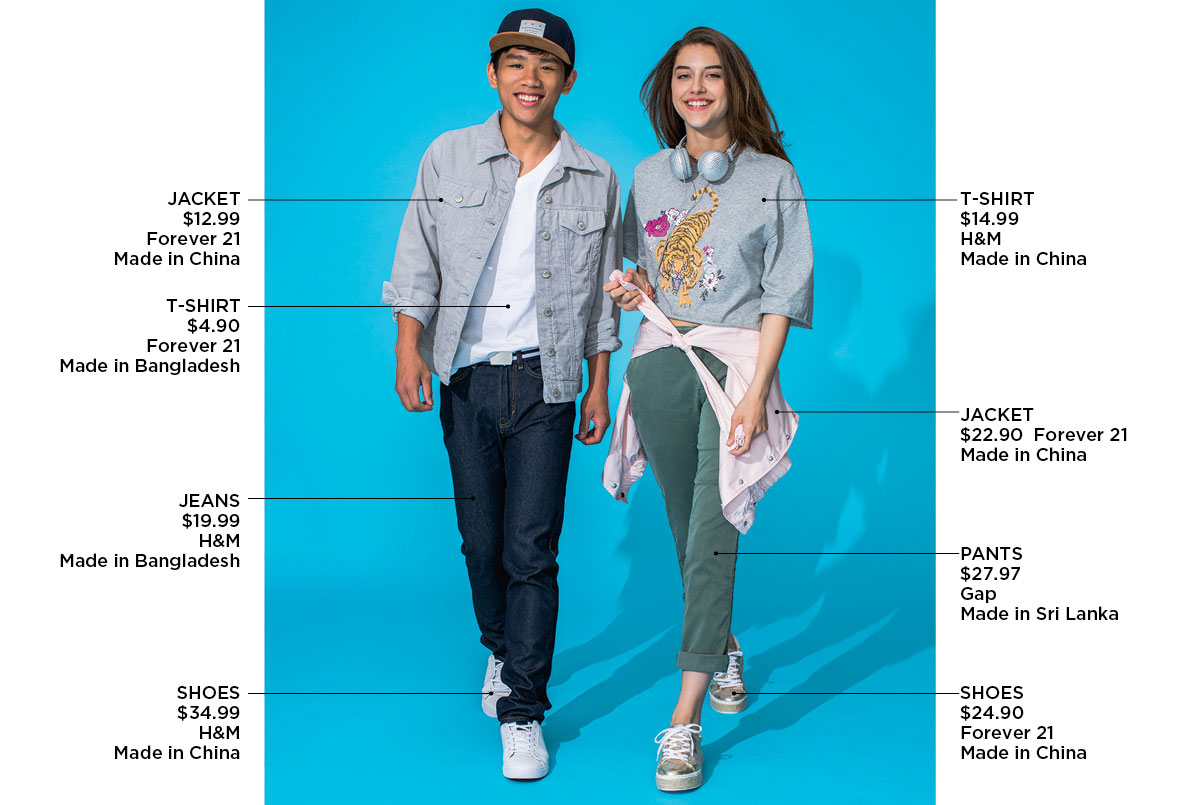
The jackets are just one example of what is known as fast fashion: trendy clothes that are designed and manufactured as quickly as possible, then sold to consumers at extremely low prices.
New fast fashion looks arrive in stores weekly or even daily. They cost so little that many people can afford to fill their closets with new outfits several times a year—then toss them the minute they go out of style.
Clothing chains such as H&M and Zara first popularized fast fashion in the early 2000s. The retail model has since spread throughout the entire fashion industry. As a result, global clothing production has more than tripled since 2000. The fashion industry now churns out more than 150 billion garments annually.
Fast fashion items may not cost you much at the cash register, but they do come at a serious price: Every day, tens of millions of people in
The trend also hurts the environment. From manufacturing garments with toxic chemicals to the fuel burned to transport the clothing around the globe, the fashion industry has become the world’s second-largest polluter, after the oil industry. Plus, millions of tons of discarded clothing pile up in landfills each year.
“A lot of what we’re throwing away hasn’t even been worn that many times,” says Elizabeth Cline, author of Overdressed: The Shockingly High Cost of Cheap Fashion. “Clothing has become a really cheap form of entertainment.”
A CHANGING INDUSTRY
Until the 1970s, most apparel worn by Americans was made in the U.S. That’s when clothing production, like a lot of manufacturing (including cars and electronics), began moving overseas, where labor costs were lower. As recently as 1990, half the clothing sold in the U.S. was made here. Today, just 2 percent is.
Most American clothing companies now manufacture their merchandise overseas, mainly in developing countries in Asia (see map, “Where Your Clothes Come From,” below ). Workers there earn a fraction of what U.S. workers make—and have fewer protections. The lower labor costs translate to lower prices for shoppers (who then buy more clothing) and higher profits for retailers. That has helped make fashion a $3 trillion global industry.
DEADLY CONDITIONS
Today, many of the world’s 75 million garment workers live in China and Bangladesh, two of the top producers of ready-made garments. Most workers are females in their teens or younger. “They’re sometimes the first one in their families to have a real job, so the family is eager to get them into the factories as quickly as they can,” says Michael Posner, an ethics professor at New York University. “It’s a very tough existence.”
Indeed, garment workers often toil in poorly ventilated rooms that are thick with fumes from the chemicals used to manufacture and dye clothes. Workers earn barely enough to survive. And if they dare miss a day because they are sick, they risk being fired.
20 billion:
The number of garments
Americans buy in a year
For Taslima Aktar, that wasn’t an option. The 23-year-old couldn’t afford to lose her job at the Windy Apparels factory in Bangladesh. So when her manager refused to give her time off to see a doctor last year about a persistent fever and cough, she accepted it.
Weeks later, Aktar passed out at work. After she was revived, her boss sent her back to her sewing machine. Shortly afterward, Aktar’s heart stopped and she died.
“We know the same thing can happen any day, to any of us,” says one of Aktar’s co-workers, who told her story to the news website Slate.
A TRAGEDY SPARKS AWARENESS
Many people didn’t give much thought to how or where their clothing was made until April 24, 2013. That’s when Bangladesh’s Rana Plaza factory building collapsed. The deadliest accident in the history of the garment industry, it killed 1,100 workers and injured 2,500 others. The building’s factories had been making clothing for global brands including Benetton, Joe Fresh, and Mango.
After the accident, many big brands pledged to improve garment factory conditions. About 200 major clothing companies partnered to create factory oversight programs in Bangladesh. In recent years, these programs have trained about 2 million workers in safety procedures. The companies have also hired engineers to inspect the garment factories that produce their clothes.
In southern China too, many factories now offer safer conditions and better wages than they did a decade ago. In some areas, the monthly minimum wage for garment workers reached $312 last year. That’s a 42 percent increase over the previous year’s minimum wage.
SLOW IMPROVEMENTS
Better working conditions and wages come at a price, however. Some factories in Bangladesh have had to reduce how much they produce per day to afford higher pay for employees and building repairs. That means the factories are less able to fill the often-massive orders from big brands. As a result, some experts say, these clothing companies may eventually shift their production to even poorer countries with fewer regulations.
Other factories can’t afford to make the major structural upgrades needed for them to be safe. (Of the 2,000 Bangladeshi factories that have been inspected so far, only 79 had passed final inspection as of March 2017.)
That’s one reason unsafe working conditions persist. Last year, a garment factory fire in India killed 13 people. Another fire this past June injured more than 20 knitwear factory workers in Bangladesh. Some jumped out of third-story windows to escape.
32 cents:
The hourly minimum wage
in Bangladesh
And even if the buildings do pass inspection, the improvements often do little to change daily life for the people who labor in them.
“We still don’t have any security in our lives,” a garment worker in Bangladesh told Slate. “Even if I am on my deathbed, they will ask me to finish making two more pieces before I die. We are nothing but machines to them.”
In Bangladesh, workers who have banded together to demand better treatment have suffered severe consequences. Last December, 1,500 workers were fired or suspended after taking part in protests. Dozens more were arrested during the demonstrations.
ENVIRONMENTAL EFFECTS
Humans aren’t the only ones suffering for fast fashion. It also takes a toll on the environment. For example, the industry consumes huge amounts of water and other natural resources. Producing enough cotton for one pair of jeans requires roughly 1,800 gallons of water. That’s the equivalent of about 106 showers.
Fast fashion also causes pollution. Take polyester, the most widely used synthetic fiber, which is made from petroleum. Manufacturing it releases dangerous gases into the air. Meanwhile, farming cotton accounts for a quarter of all the pesticides used in the U.S. (Our nation sends about 70 percent of the cotton it grows overseas, where it’s turned into clothing.) Some of those pesticides can cause asthma and other health problems. The chemicals also pollute freshwater and wells near farms.
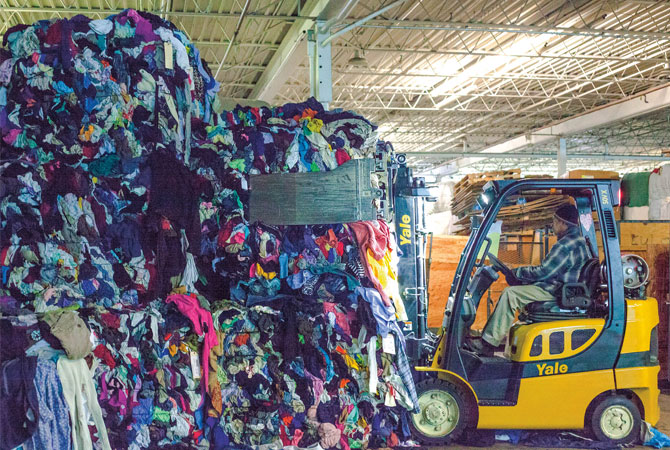
A worker with piles of discarded clothing at a textile recycling plant in New Jersey
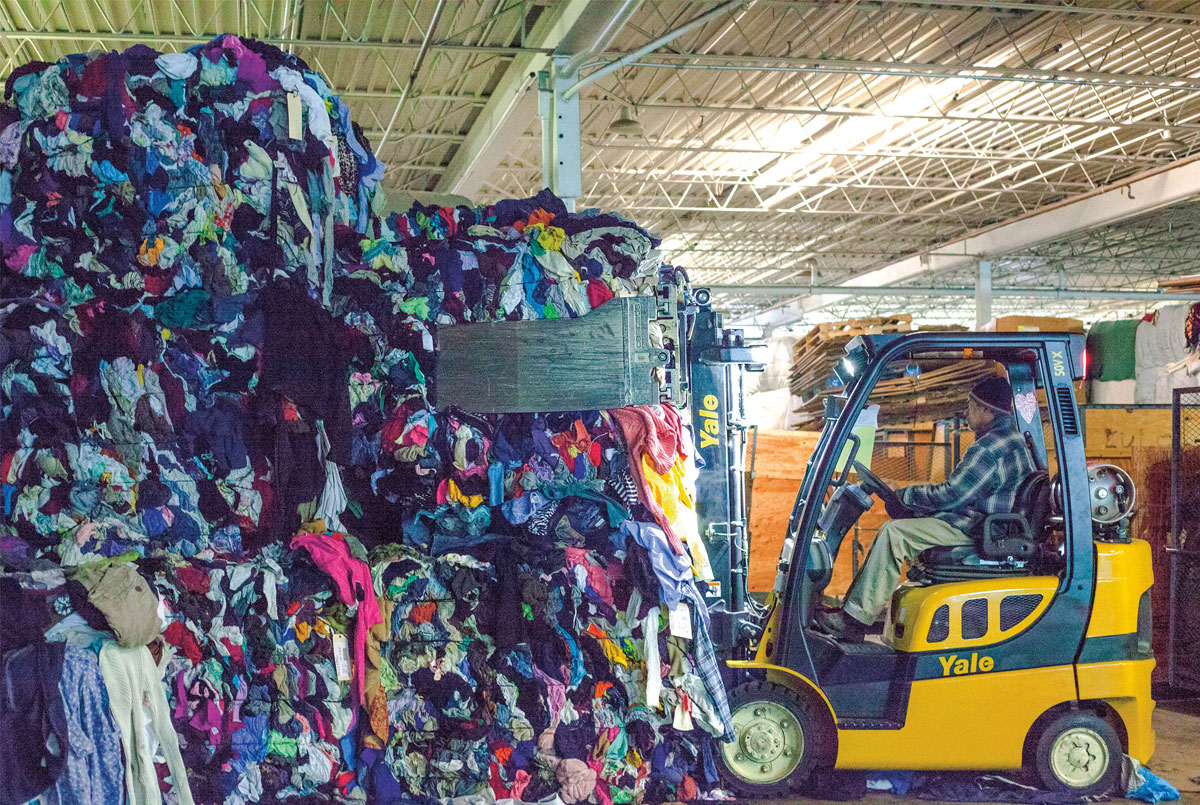
The damage doesn’t end once clothing has been made. The average American trashes about 76 pounds of clothes and shoes every year. Most of that is burned or piled in landfills, where polyester and other synthetic fibers can take hundreds of years to break down. Discarded clothing can also contain chemicals left over from the manufacturing process, which can spread into groundwater.
“A lot of the problems in the fashion industry are things that are happening in other places: air and water pollution in China, poverty and low wages in Bangladesh,” notes Cline. “[But] the waste is happening in our own backyard.”
MOVING FASHION FORWARD
As more people have become aware of the ugly side of fast fashion, the push for ethically made, sustainable clothing has grown.
In the U.S., hundreds of new businesses are creating garments out of recycled or organic fabrics. These companies get their materials from American factories, where they can better monitor working conditions.
Big brands are trying to be more eco-conscious as well. H&M, for example, offers store credit to customers who recycle their unwanted clothing at its retail locations.
For now, though, eco-friendly and ethically made garments are often harder to find and more costly than other fashions. That won’t be the case for long, Cline predicts. “I think we’re going to see big brands become leaders in sustainable clothes and make them accessible and more affordable,” she says.
But experts agree it will take more than just efforts by clothing companies to remedy the problems of fast fashion. Local factory owners, global retailers, and Western governments all must play a part, says Posner: “You need a shared model where everybody’s pitching in.”
That includes teen consumers, to whom much of fast fashion is marketed. If young shoppers educate themselves about where and how their clothes are made, and think carefully about how much they buy, it can make a real difference, experts say (see “How to Help,” below).
“It’s everybody’s problem,” says Posner. “And it’s everybody’s responsibility to come together and solve it.”
CORE QUESTION: What is being done to solve the problems created by fast fashion? Cite evidence from the text in your answer.
The Triangle Factory Disaster
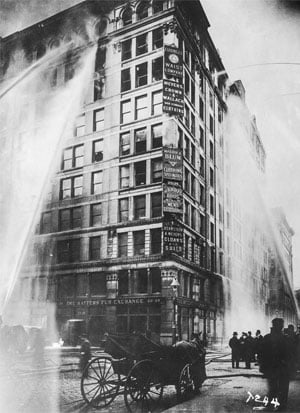
Firefighters battle the Triangle factory blaze.
The fire that broke out on March 20, 1911, at the Triangle Waist Company factory in New York City killed 146 people—and had an enormous impact on the nation.
Fueled by oily floors and bins of flammable material, the fire spread quickly through the factory, where young immigrants were making shirts. The building had no sprinkler system and many workers burned to death behind locked exit doors.
The Triangle factory fire was one of the deadliest workplace disasters in American history, and it prompted swift changes. Within a few years, New York had passed 36 safety laws, spurring other states to do the same. By 1938, Congress had banned child labor, set a national minimum wage, and guaranteed overtime pay. Those laws set important standards for workers in the garment industry and others in the United States, but many other countries have yet to establish these sorts of labor regulations.

Workers assemble garments in a Bangladesh factory.
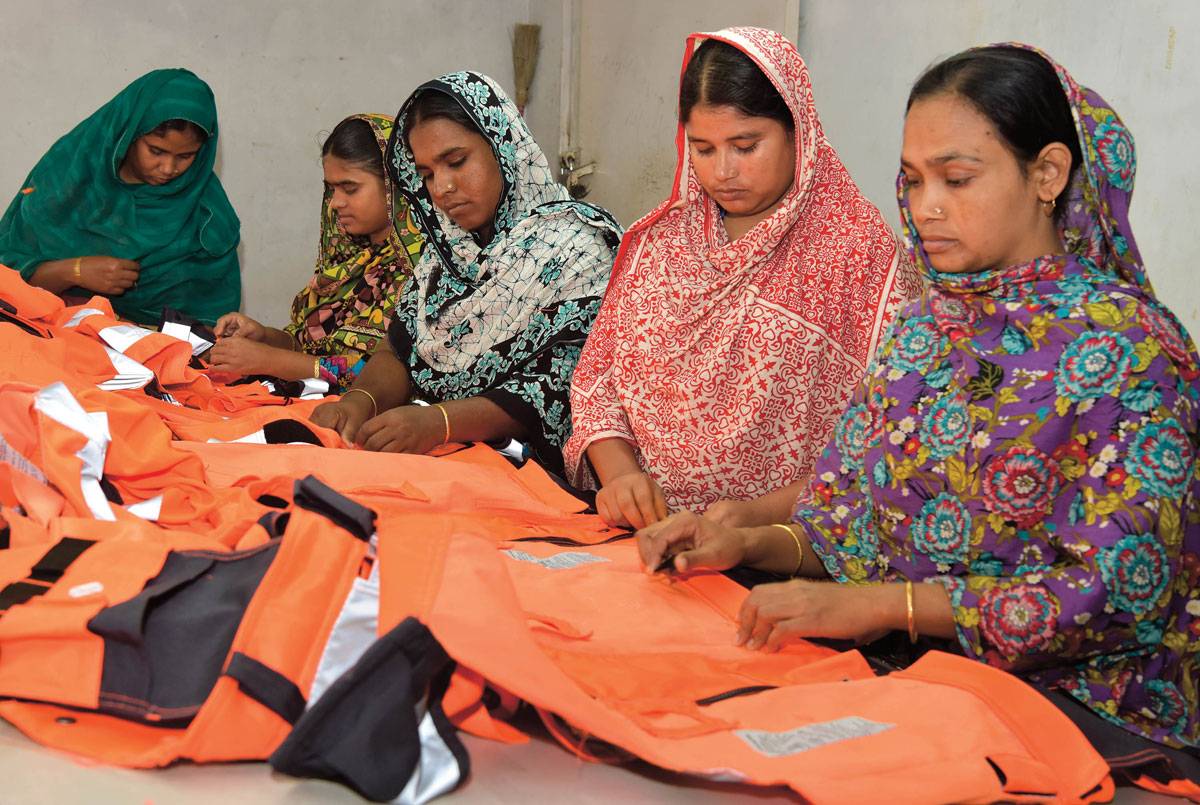
Fast Fashion’s Upside?
The clothing industry offers people in developing countries a rare chance to find jobs—especially women. In Bangladesh, garment factories helped lift more than 20 million people out of extreme poverty from 1991 to 2010. Though the work is far from ideal, it’s better than nothing, Posner says. “I think it’s really important that these young people have jobs.”
How to Help
Trade, Don’t Toss
Instead of buying new clothes, swap with friends
or shop at secondhand stores to refresh your wardrobe.
Invest More
If you need something new, consider spending more
to buy ethically sourced, sustainable clothes.
Raise Awareness
Urge brands to be transparent about how their items are made.
Take a photo of your clothing label and post it on social media
using the hashtag #whomademyclothes.
Where Your Clothes Come From


MAP SKILLS
1. What is the capital of Bangladesh?
2. What is the value of the clothing that Bangladesh exported to the U.S. in 2016?
3. Which countries exported more than $4 billion of clothing each to the U.S.?
4. Which major exporter is farthest south?
5. Which of the labeled countries was the biggest exporter of clothing to the U.S.?
6. How much more did that country export to the U.S. than the country in second place?
7. Which labeled country exported the least?
8. Which countries exported less than $1 billion?
9. The equator runs through which of the labeled countries?
10. Which labeled countries have coastline on the Arabian Sea?

